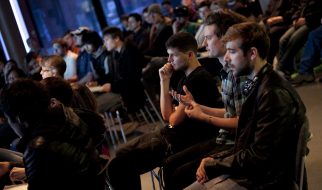In a modern world, game fans are no longer surprised, when finding out that a certain game was created by only two or three people. But no matter how accessible and intuitive game design tools have become, the titles created by a single person still make us admire its authors. These creators are people, capable of implementing a large-scale gaming idea without any help from others. They show a remarkable level of self-discipline and perseverance. Unfortunately, in most cases, such game designers do not actually get the desired results. But over time, the gaming industry has increasingly replenished with examples of the exceptional success of individual game designers, which is often inaccessible to many AAA-titles. So let’s take a look at some of them.
CAVE STORY
Designer: Daisuke Amaya
Year: 2009
Japanese game designer Daisuke Amaya, also known as “Pixel” created the cult game called Cave Story all by himself. During the 5 years of development, his life has radically changed. Daisuke started his side project while he was still a student and by the time of the game release, he was already working in the office and had a family.
When Daisuke Amaya started to develop the Cave Story, he did not have any specific ideas prepared beforehand. His first step was writing music for the main menu and almost everything else was created on the go. The only compass in his design decisions was Amaya’s favorite childhood games, like Metroid and Super Mario Bros. From time to time he would borrow some gameplay elements, such as the head of the main character on the background.
The Cave Story has quickly acquired a cult status among the gaming community. In addition, initially, the game was available for free, which is always a great bonus for the users. Later the new improved version called “Cave Story+” was released. And in 2011 was released a full-fledged remake for Nintendo 3DS – Cave Story 3D. In 2015 Daisuke Amaya and designer Ms. Kawanaka released the next big game called Kero Blaster.

Cave Story by Daisuke Amaya
LONE SURVIVOR
Designer: Jasper Byrne
Year: 2012
In case of Lone Survivor, the game author Jasper Byrne was not sure if the game will ever be released till the very last minute. Despite the fact, that Jasper has been a font of programming since the very childhood, he still always took game design only as a fun hobby. Before the release of Lone Survivor, he has been traveling around the world, writing drum and bass music for 11 years. By the way, many actually recognize the developer by his musical contribution to the soundtracks of Hotline Miami.
Jasper Byrne started working on Lone Survivor in around 2005 after thinking about the concept of dreams. He liked that dreams are considered to be limitless and wanted to build a game around this idea.
From the very first minutes of gameplay, it becomes clear that Lone Survivor is not a typical horror game like, for example, the works of Frictional Games. Similar to Silent Hill, Jasper’s game is filled with a creepy atmosphere and psychological metaphors. Jasper takes the main theme very seriously and designs the game mechanics in correspondence to it. Lone Survivor has a total of five endings. In order to make the ending much more invisible, Byrne did not introduce the moral indicators to the player.

Lone Survivor by Jasper Byrne
STARDEW VALLEY
Designer: Eric Barone
Year: 2016
Have you ever seen the gaming community taking so much care of developers that ask them to rest more and fix bugs when they have the time? This is what happened with Eric Barone, the author of the farm simulator called Stardew Valley. This game combines the best elements of the first parts of Harvest Moon and Terraria, Minecraft and Rune Factory.
Baron has been developing all the code, pixel graphics and even music over the course of four years. He often spent 10 hours a day creating the game while working as a ticket seller in the local theatre at the same time. It seems amazing to know that Baron did not have any game design or development experience prior Stardew Valley, including no knowledge of pixel graphics.
Everything started when Eric decided to make a small clone of his beloved game Harvest Moon. But as it usually happens, the ambitions of the game designers grow in a proportion to the development of the project. Finally, Eric decided to move the deadline for two and then for four years. Baron says that his secret of the success is self-discipline. He often mentions that it is much easier to stay productive when working on a personal project, rather than on someone else’s.
The Baron’s relationship with the players deserves a special attention. Starting from 2012, he actively shared all the details of the game development process on Reddit and always listened to the opinion and suggestions of the users. The game community fell in love with Eric even more, when he refused to take money from players through the Early Access. Players have repeatedly written about their firm intention to purchase the game for money. And in some cases, people would buy several copies of Stardew Valley in order to distribute it to those who did not have the opportunity to pay for it.

Stardew Valley by Eric Barone
PAPERS, PLEASE
Designer: Lucas Pope
Year: 2013
Back in the 90s game designer Lucas Pope together with friends founded his own studio called Ratloop. However back then nothing good came out of it. But when, after all, the programmer got a job at a company that produces world-famous AAA-titles, Lucas realized that he wants to return to his independent days. Having finished his work on Uncharted 2: Among Thieves, Lucas moves to Japan with a goal to start developing games with more experimental gameplay. In addition, Pope stayed in Singapore for some time, helping a friend with a project.
During the constant traveling and flights, Lucas became interested in the work of customs inspectors. He came up with an idea to develop a game in which the main character would have to try not to get deceived, rather than having a more traditional scenario where one has to deceive the system.
The main goal of the Papers, Please game is to alternately consider the cases of citizens passing through the border of the fictitious country by using all sorts of tools and instructions. At first, this process seems to be too simple and routine, but the games become more complicated with time. The background of the whole game is a personal life of the protagonist, which is directly influenced by his decisions during the verification of the documents. For example, too big bribes will not be ignored by the authorities, while refusing gangsters to enter the country can result in the killing of the relatives.
Papers, Please was a great success. In three years it sold three million copies and won several indie awards. However, the sequel should not be expected. By the end of the development, Lucas got so tired that he now takes on much smaller projects.

Papers, Please by Lucas Pope


